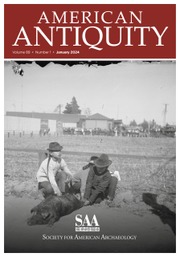Article contents
Growth and Aggregation at Canyon Creek Ruin: Implications for Evolutionary Change in East-Central Arizona
Published online by Cambridge University Press: 20 January 2017
Abstract
Tree-ring data from the Canyon Creek Ruin, east-central Arizona, are analyzed to evaluate two competing interpretations of pueblo growth at this well-preserved cliff dwelling. Despite an anomalous dating pattern, a logistic model best describes pueblo growth. Room construction activity is linked to population increase, which, in turn, may be divided into two varieties: natural increase, and immigration of households into the settlement. Logistic growth also accounts for population increase within the larger area of the Grasshopper region. I review the processes promoting both local and regional population increase, as well as subsequent abandonment of the mountains of Arizona. I suggest that rapid depopulation may have occurred after A.D. 1375 because late prehistoric communities lost access to nonlocal goods that had previously allowed populations to increase beyond local resource constraints.
- Type
- Research Article
- Information
- Copyright
- Copyright © The Society for American Archaeology 1983
References
References Cited
- 10
- Cited by


